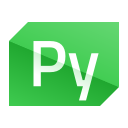Creating a Simple PySide2 Dialog Application¶
This tutorial shows how to build a simple dialog with some basic widgets. The idea is to let users provide their name in a QLineEdit, and the dialog greets them on click of a QPushButton.
Let us just start with a simple stub that creates and shows a dialog. This stub is updated during the course of this tutorial, but you can use this stub as is if you need to:
import sys
from PySide2.QtWidgets import QApplication, QDialog, QLineEdit, QPushButton
class Form(QDialog):
def __init__(self, parent=None):
super(Form, self).__init__(parent)
self.setWindowTitle("My Form")
if __name__ == '__main__':
# Create the Qt Application
app = QApplication(sys.argv)
# Create and show the form
form = Form()
form.show()
# Run the main Qt loop
sys.exit(app.exec_())
The imports aren’t new to you, the same for the creation of the QApplication and the execution of the Qt main loop. The only novelty here is the class definition.
You can create any class that subclasses PySide2 widgets. In this case, we are subclassing QDialog to define a custom dialog, which we name as Form. We have also implemented the init() method that calls the QDialog’s init method with the parent widget, if any. Also, the new setWindowTitle() method just sets the title of the dialog window. In main(), you can see that we are creating a Form object and showing it to the world.
Create the Widgets¶
We are going to create two widgets: a QLineEdit where users can enter their name, and a QPushButton that prints the contents of the QLineEdit. So, let’s add the following code to the init() method of our Form:
# Create widgets
self.edit = QLineEdit("Write my name here..")
self.button = QPushButton("Show Greetings")
It’s obvious from the code that both widgets will show the corresponding texts.
Create a layout to organize the Widgets¶
Qt comes with layout-support that helps you organize the widgets in your application. In this case, let’s use QVBoxLayout to lay out the widgets vertically. Add the following code to the init() method, after creating the widgets:
# Create layout and add widgets
layout = QVBoxLayout()
layout.addWidget(self.edit)
layout.addWidget(self.button)
# Set dialog layout
self.setLayout(layout)
So, we create the layout, add the widgets with addWidget(), and finally we say that our Form will have our QVBoxLayout as its layout.
Complete code¶
Here is the complete code for this tutorial:
import sys
from PySide2.QtWidgets import (QLineEdit, QPushButton, QApplication,
QVBoxLayout, QDialog)
class Form(QDialog):
def __init__(self, parent=None):
super(Form, self).__init__(parent)
# Create widgets
self.edit = QLineEdit("Write my name here")
self.button = QPushButton("Show Greetings")
# Create layout and add widgets
layout = QVBoxLayout()
layout.addWidget(self.edit)
layout.addWidget(self.button)
# Set dialog layout
self.setLayout(layout)
# Add button signal to greetings slot
self.button.clicked.connect(self.greetings)
# Greets the user
def greetings(self):
print ("Hello %s" % self.edit.text())
if __name__ == '__main__':
# Create the Qt Application
app = QApplication(sys.argv)
# Create and show the form
form = Form()
form.show()
# Run the main Qt loop
sys.exit(app.exec_())
© 2022 The Qt Company Ltd. Documentation contributions included herein are the copyrights of their respective owners. The documentation provided herein is licensed under the terms of the GNU Free Documentation License version 1.3 as published by the Free Software Foundation. Qt and respective logos are trademarks of The Qt Company Ltd. in Finland and/or other countries worldwide. All other trademarks are property of their respective owners.
